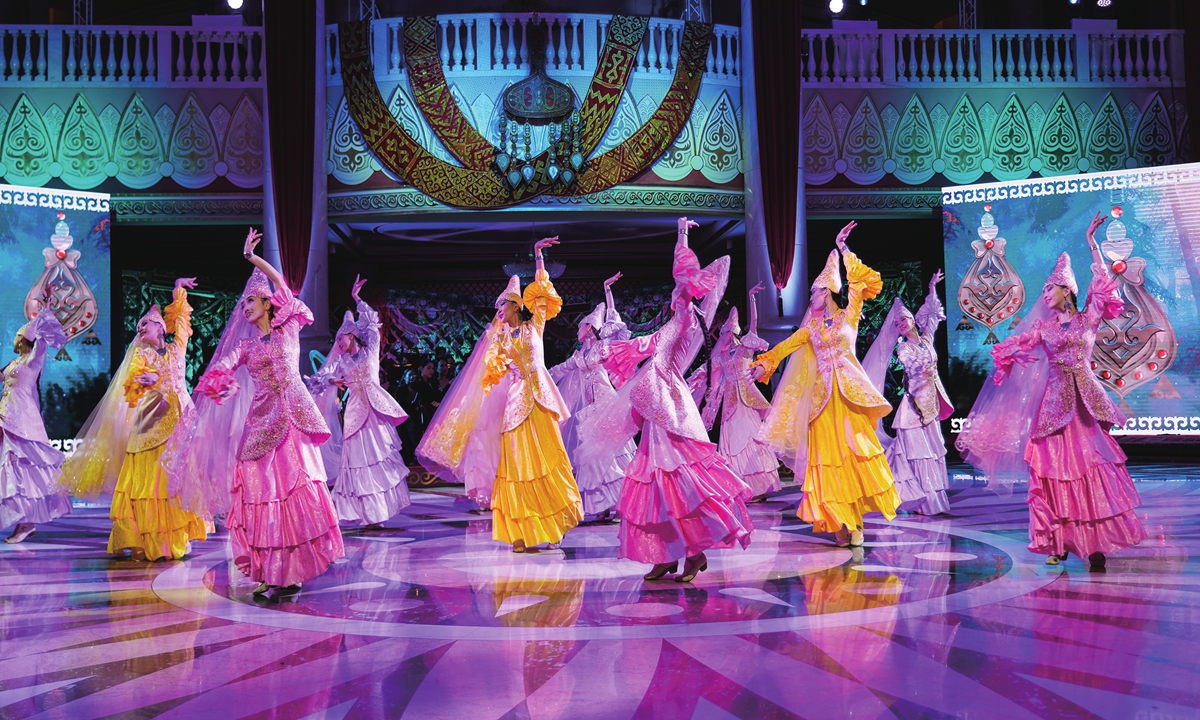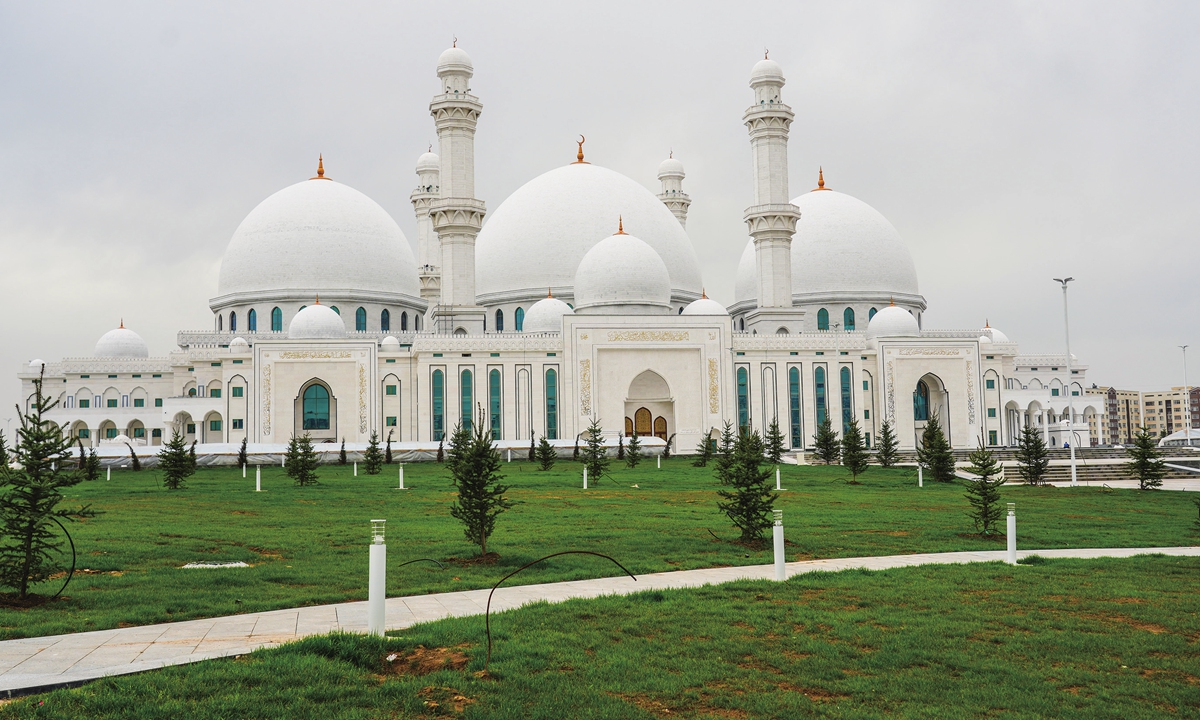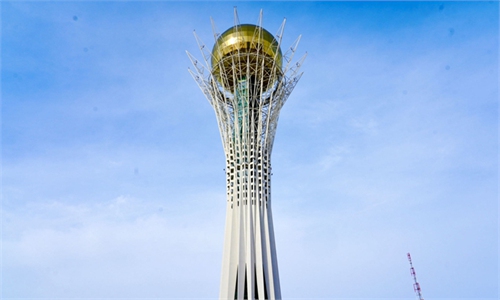ARTS / CULTURE & LEISURE
A walk through Kazakhstan's Nauryz festival
The Silk Road Revisited

Nauryz ball Photo: Deng Zijun/Global Times
From the Altai Mountains to the expansive steppes of the Kazakh heartland, Kazakhstan showcases a variety of beautiful natural scenery. A visit during Nauryz festival will allow you to see a vibrant cultural heritage and the hospitality of this Central Asian country.
A capital with diversity
Astana, the capital city of Kazakhstan, is a modern and vibrant metropolis. With its futuristic architecture, bustling streets, and rich cultural heritage, Astana is a must-visit destination for travelers looking to explore this fascinating region.
One of the most iconic landmarks in Astana is the Baiterek Monument. Standing at a height of 97 meters, an equivalent of 35 floors, this iconic tower symbolizes the aspirations and ambitions of the Kazakh people. The tower's unique design features a golden sphere at the top, which represents the sun, and a tree-like structure that symbolizes the mythical tree of life.
Visitors to the Baiterek Monument can enjoy panoramic views of the city and the surrounding landscape at the top. The observation deck offers stunning vistas of Astana's modern skyscrapers, as well as the vast steppes and mountains that stretch out beyond the city limits.
Another iconic landmark in the city is the Grand Mosque, which is the largest mosque in Central Asia and one of the world's 10 largest mosques. Built in three years and opened in 2022, the mosque has four minarets with a height of 130 meters and an 83.2-meter-high main dome.
The large blue dome of the mosque stands out from afar. Access to the mosque is free, but shoes need to be taken off, and blue robes are provided to women at the entrance. Inside the mosque, visitors are greeted with spacious prayer halls and wedding halls that can accommodate up to 235,000 worshippers at a time. The interior of the mosque is adorned with ornate decorations, including intricate tile work, colorful carpets, and beautiful chandeliers.

A mosque in Shymkent, Kazakhstan Photo: Deng Zijun/Global Times
Celebrations of NauryzNauryz, which means "new day" in Persian, is one of the most important national holidays in Kazakhstan, marking the advent of spring and the beginning of the new year. With a history of over 3,000 years, this ancient festival is a time for people to come together and enjoy festivities with great enthusiasm and joy.
The festival is not unique to Kazakhstan, as it can be traced back to the ancient nomadic tribes and is observed by many countries along the Silk Road, including those in Central Asia, the Balkans, the Caucasus, the Black Sea region, and the Middle East. Thus the holiday is known by various names such as Navruz, Nawruz, Norooz, Nowruz and Nevruz in different countries.
The festivity usually falls on March 21st or 22nd each year. But this year the Kazakhstan government implemented a new format of the Nauryz celebration - the Nauryznama decade, which spans 10 days from Korisu (Greetings) Day on March 14 to Tazaru (Cleansing) Day on March 23.
Although this period coincides with the Muslim holy month of Ramadan (March 10-April 9), which means people have to reconcile their celebrating traditions with the fasting obligation of Ramadan, Kazakhstan has developed a comprehensive plan for Nauryz celebrations, including over 10,000 events across the country.
On March 19, outside of the Astana Opera in the capital of Kazakhstan, soldiers dressed in medieval nomadic warrior costumes, holding long swords and axes, stood on either side of the gate to welcome guests. Walking into the main venue, what catches the eye was a huge nomadic village, where various classic folk performances were staged.
Several girls dressed in traditional clothing sat in a circle on the ground playing a traditional Kazakh game called Assyk, which involves two players competing to knock out each other's Assyks (chess-like pieces traditionally made out of the talus bone of a sheep) from the field. Two young men wrestled in the center of the field while a group of people were playing "Arkan tartu" (tug of war) amidst cheers and shouts on the other side of the venue.
As music played, guests including government officials, diplomats and their counterparts and cultural enthusiasts joined in a lively dance led by professional dancers.

Qymyz, or horse milk Photo: Deng Zijun/Global Times
Nomadic roots
Horses have always been an important part of Kazakh culture, as many of its people are descendants of nomadic tribes. Horses are not only used for transportation and work, but also for leisure activities such as horse racing.
In a horse farm on the outskirts of the southern city of Shymkent in Kazakhstan on March 20, horse racing games in celebration of Nauryz were in full swing. Amid the cheers of the crowd, female riders were leaping over obstacles on horseback. The most eye-catching game is called Kume Alu, in which players are challenged to collect as many bags of coins as possible while riding on horseback.
Astana will host the 5th World Nomad Games in September. About 4,000 participants from over 100 countries will take part in 20 competitive and 10 demonstration events.
As much as horses are revered, their meat is also considered a delicacy in Kazakhstan. To Kazakh people, horse meat is a source of strength and vitality. The most popular way to prepare horse meat is by grilling or boiling it. The meat is often marinated in a mixture of spices and herbs before being cooked to enhance its flavor and it is also used in traditional dishes such as Beshbarmak, a dish made with boiled horse meat and noodles.
Qymyz, or fermented mare milk, is the country's national drink. Drinking qymyz is not only a cultural tradition but also a way to connect with nature and the nomadic way of life that is still prevalent in Kazakhstan. It is believed to have numerous health benefits, such as improving digestion, boosting the immune system, and providing essential nutrients.

